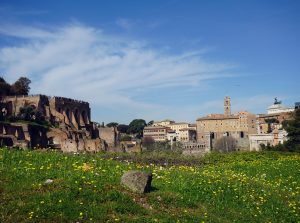On Tuesday morning, I woke up promptly at 7 AM and finally made my way inside the Colosseum with a group of friends. Even by 8:30, there was already a long line, but, having waited three months to go in, our excitement made up for the lengthy queue. Our tour guide informed us that the entirety of the amphitheater used to be covered in brightly colored marble, which was later taken and used for the creation of St. Peter’s Basilica. The reason why half the Colosseum partially crumbled is because the metal supports were removed from the structure to be used elsewhere. It’s a miracle that so much of it still stands!


After we explored the Colosseum, we made our way into the Forum, Rome’s center. The ruins emerged from the fresh, green grass, as if they were one with the dandelions, sprinkled across the terrain like parmesan cheese.


The following day, our Italian Cinema class went on a field trip to Cinecittà, the “Hollywood” of Rome founded by Mussolini in 1937. As we moved from set to set, we hopped from country to country, era to era, finally finding ourselves in Ancient Rome. This set, used for HBO’s Rome series, took nine months and millions of dollars to build.


The ruins that I had stood amongst just the day before were now in perfect condition, colored and standing before me just as they had thousands of years ago. The only difference? The “stones” were all hollow!


Experiencing Rome across two time periods was truly incredible. Thank you to our professor, Carolina, for organizing the field trip!
Sabine
